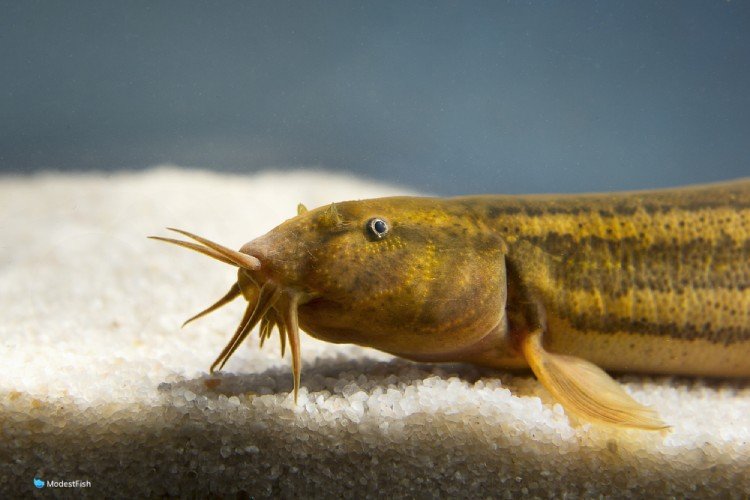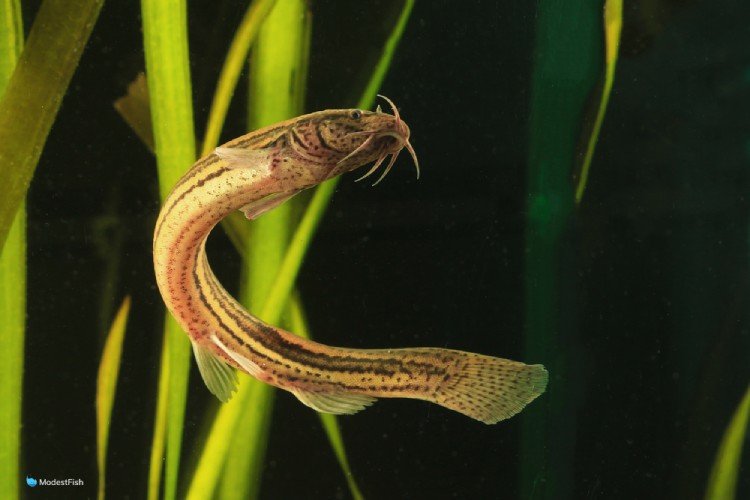The Dojo Loach (golden dojo loach) is an interesting, unique fish who is a model community tank member.
They’re highly social fish with tons of personality and interesting quirks when given the proper conditions.
In this guide, I’ll teach you how to provide the best dojo loach care; from setting up the tank, to getting the water parameters right, diet, and creating the optimal environment for your dojo loach to thrive.
Care Overview For Dojo Loach
- Care Level: easy
- Min. Tank Size: 100 gallon (379 liter)
- pH: 6.5-8.0
- Temperature: 50°-75°F (10°-24°C)
- Diet: omnivore
- Temperament: peaceful bottom feeder
- Lifespan: 8-10 years
- Size: 12 inches (30 centimeters)
- Family: Cobitidae
- How many dojo loaches can be kept together: should be kept in a group of three or more
- Scientific Name: Misgurnus anguillicaudatus
- Common Name: dojo loach, golden dojo loach, weather loach, pond loach
Dojo Loach Size & Appearance

Dojo loaches (Misgurnus anguillicaudatus) look kind of like a short eel, however they are not a true eel at all. Dojo loaches can live for 8-10 years and grow up to 12 inches. Their bodies are long and skinny, kind of snake-like, and their fins are quite short and close to the body.
They have six fleshy barbels that surround their downturned mouths. These whisker-like appendages are used to search along the substrate for bits of food.
Barbels have taste buds on them that help dojo loaches find little bits of food in the cracks and crevices in the pebbles and sand at the bottom of the waterway.
In nature, dojo loaches are a light gray color and covered from head to tail with dark brown speckles. But, there are several captive bred color varieties available in the aquarium trade.
The most common is golden dojo loach. I’ve actually seen the golden variety much more often than the natural speckled form. There is also a peppered dojo loach (not to be confused with the peppered loach) that has much smaller speckles than the natural form.
Species Profile
Dojo loaches (Misgurnus anguillicaudatus) are native to Eastern Asia but have become an invasive species in Europe, Australia and the United States.
They inhabit freshwater lakes, rivers and ponds in temperate environments.
This species is nocturnal by nature, emerging at night to scour the substrate for small crustaceans, shrimp, fish eggs, dead fish, insect larvae, basically anything edible that’s resting along the bottom.
Dojo loaches are highly social shoaling fish that always travel in high numbers.
This species is also sometimes called a “weather loach” because it swims around erratically when the barometric pressure drops before a storm.
How to Set Up a Dojo Loach Tank
Let’s now go through how to set up your dojo loach tank so you can provide the best care for your pet.
Dojo Loach Tank Size
Dojo loaches can reach lengths of 12 inches (30 centimeters) and require a large swimming area.
They also need to be kept in a group of at least three, although higher numbers are preferable if possible.
Because of these factors, I recommend they be housed in at least a 100 gallon (379 liter) tank.
Filtration
You will need a filter on your tank if you want to keep dojo loaches. These large fish will put off a substantial amount of waste and their water will become toxic if it is not properly filtered.
Fish create urine and feces that they release into the water around them.
Don’t judge them, their bathroom options are limited.
But seriously, fish waste accumulates in the tank and starts to rot. This creates ammonia (NH3) that’s released into the water column.
Ammonia is very, very toxic to fish. It only takes one drop of ammonia in 13 gallons of water to cause fish stress, possibly even death for some species.
With no filtration, fish waste accumulates and puts off more and more ammonia until the water in the aquarium is an unlivable toxic soup.
It might seem like all aquarium filters do is just pump water around the tank, but they actually do much more.
As the water is pumped through the filter, it goes through several kinds of filter media. One kind in particular, biomedia, is covered with beneficial bacteria that can help detoxify aquarium wastes.
These beneficial bacteria in the filter eat ammonia and transform it to a chemical called nitrite (NO2 -1) and then turn the nitrite into nitrate (NO3-).
Nitrate is fairly nontoxic and can be allowed to build up in the aquarium in between water changes.
For fish as large as dojo loaches you will need a filter that can hold a substantial amount of biomedia.
I would recommend using a canister filter if you plan to keep this species. The large capacity of a canister will give you lots of room for biomedia to keep up with all the waste produced in the tank.
There is a process to get beneficial bacteria to grow in the filter of a newly established aquarium, a major part of the Aquarium Nitrogen Cycle.
Water Parameters For Dojo Loach
- Temperature: 50°-75°F (10°-24°C)
- pH: 6.5-8
- Ammonia/Nitrite: 0
- Nitrate:>40 ppm
- GH: 3-15 dGH
- KH: 4-8 dKH
Heater
Normally, this is the section where I urge readers to make sure they add a heater to their tank, but dojo loaches are a little bit different.
This species actually does best at room temperature or lower. They can tolerate tropical water temperatures for short periods of time, but they should not be kept in this temperature range long term.
So, no need to add a heater for these guys. They would really rather you didn’t.
Substrate
Fine sand is the best kind of substrate to use for dojo loaches. This species loves to dig in the substrate. They will sometimes dig down and bury themselves completely in times of stress.
So, I highly recommend maintaining a sand bed that is at least 2 inches (5 centimeters) deep.
Sharp gravel or a clay substrate could scratch a loach’s barbels, face or sides as they tried to burrow down.
Lighting
Dojo loaches don’t really have specific lighting requirements. They are a nocturnal species that actually prefers the light to be off.
Over the years, I have definitely found that running a red light at night encourages shy, nocturnal tank inhabitants to emerge and let you see them.
Lots of planted aquarium lights have blue “moon lights,” and they’re OK, but the red really works the best for timid fish.

Plants and Tank Decorations
This can be a shy species and they especially like to hide during the day. It’s best to provide lots of hiding spaces so they can retire when they feel stressed.
Load up their tanks with lots of smooth rocks, driftwood and decor. The more caves and little dens this fish has to choose from, the better.
Since dojo loaches like to dig so much, they are notorious for uprooting plants that are grown in the substrate.
You can, however, put plants in pots to protect them from marauding dojo loaches.
Another good strategy would be to anchor plants to rocks and driftwood, like anubias, Java fern, African water fern or flame moss.
Dojo loaches don’t want to tear up the plants, they just do it by accident when they’re rooting around.
So growing plants that can’t be pulled up will let you enjoy some beautiful greenery without the constant headache of dealing with uprooted plants.
Dojo Loach Diet
This species is not at all picky when it comes to food. Dojo loaches will gladly devour anything from flakes to pellets and sinking wafers.
Don’t count on them being able to just live off the scraps left over from your top dwelling fish. These guys get to be pretty hefty, so you’ll need to add food specifically for them.
They should get a staple diet of high quality sinking food, like Omega One Catfish Pellets or New Life Spectrum Large Fish Formula.
The pellets can be supplemented with frozen bloodworms and some occasional brine shrimp.
Giving your dojo loaches a varied diet of high-quality fish food helps ensure they get all the nutrients they need to be happy and healthy.
Since dojo loaches can be very shy when the lights are turned on, it’s best to add some food for them when the lights get turned off for the night. That way, the food won’t be eaten up by diurnal fish before the dojo loaches have a chance to get any.
Dojo Loach Breeding
Dojo loaches don’t often spawn in home aquariums. In their natural habitat, they breed during the rainy season.
There are lots of accounts of people accidentally triggering a spawn by performing large water changes. So, you can try to trigger them to breed by doing large water changes with water that is slightly cooler by two or three degrees to simulate their environment being flooded with rain.
Once the fish begin to spawn, the male and female will swim together around the tank and the female will release a few dozen eggs into the water as the male fertilizes them.
The eggs are very sticky and will glue themselves to any surface they touch as they fall.
If at all possible, it’s best to remove the eggs and place them in a separate tank. 1-3 days after being laid, the eggs will begin to hatch, and the fry should become free swimming a few days after that.
The babies can be fed liquid fry food their first week and can then graduate to baby brine shrimp and crushed flake.
Dojo Loach Tank Mates
This species is super peaceful and is safe to keep with other peaceful fish species.
However, they do get fairly large and even really peaceful fish will sometimes eat tank mates small enough to fit in their mouths.
So you’re best to go with fast swimming fish that can easily outswim the dojo loaches if they decide to make one of their roommates into a midnight snack.
The other big consideration is the temperature requirements. Dojo loaches are happiest in water that is much cooler than what most tropical species can tolerate. This severely limits what species you can keep with your dojos.
Some good choices include:
- Goldfish – fancy or comet goldfish
- Zebra danios
- White cloud mountain minnows
- Rosy barb
- Hillstream loach
- Buenos Aires Tetra
- Bloodfin tetra
- Gold barb
Is a Dojo Loach Right for You?
Dojo loaches are really interesting fish that make unique additions to an aquarium. They are a good scavenger that will take care of uneaten food left by top dwelling tank mates.
They’re also a very peaceful fish that does not show aggression towards tank mates.
But, these fish are not for everyone.
They require very large aquariums, much larger than most hobbyists can manage.
Also, they are a cool water fish that needs colder temperatures than most tropical species. So, they are not a good choice for tanks kept at temperatures in the mid-70s and above.
This is a serious limitation that excludes them from the majority of home aquariums.
But, if you happen to run a large cold water set up, a school of dojo loaches could be a very interesting part of your tank cleanup crew.
I hope you find this article helpful.
I wish you and your fish the very best!
